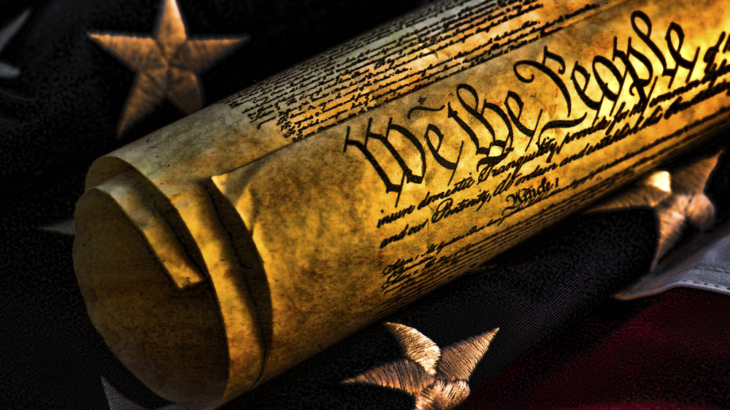
Essay Read By Constituting America Founder, Actress Janine Turner
Though we might give to such a government certain powers with safety, yet to give them the full and unlimited powers of taxation and the national forces would be to establish a despotism, the definition of which is, a government in which all power is concentrated in a single body. To take the old Confederation, and fashion it upon these principles, would be establishing a power which would destroy the liberties of the people… It was seen that the necessary powers were too great to be trusted to a single body; they, therefore, formed two branches, and divided the powers, that each might be a check upon the other…The State governments possess inherent advantages, which will ever give them an influence and ascendency over the National Government, and will for ever preclude the possibility of federal encroachments. That their liberties, indeed, can be subverted by the federal head, is repugnant to every rule of political calculation. – Alexander Hamilton in a speech, Compromises of the Constitution, June 20, 1788 during the New York Ratifying Convention.
On federal-state confrontation, Hamilton—an aide to General George Washington during the American Revolution and then our first Secretary of the Treasury— in speaking on this topic quoted above, as he argued for the ratification of the United States Constitution: “We might give to such a government certain powers,” he said of the proposed federal government, and yet, he continued, “to give them the full and unlimited powers of taxation and the national forces would be to establish a despotism . . . establishing a power which would destroy the liberties of the people.” Hamilton wanted the states and their people to have power, too, as a counterweight to the danger of federal usurpation. These warnings note that liberty can be destroyed through abrupt or gradual means either by a domestic tyrant or if a foreign force overwhelms it. Hamilton had the answer for both: “The State governments possess inherent advantages, which will ever give them an influence and ascendency over the National Government, and will for ever preclude the possibility of federal encroachments.”
Hamilton made it plain he sympathized with the states: “That their liberties, indeed, can be subverted by the federal head, is repugnant to every rule of political calculation.” In other words, keep the states intact, as a bulwark of freedom for themselves, and as a bulwark against national impingement. This is part of the genius of the Constitution: for every legitimate power, there’s a legitimate counter-power.
As an entity intended to be indestructible, each state has a right, and a duty, to ensure its own integrity and survival. For example, the federal government leads the national defense, but if it won’t, the states must act. For example, one of the state constitutions declares, “Texas is a free and independent State, subject only to the Constitution of the United States, and the maintenance of our free institutions and the perpetuity of the Union depend upon the preservation of the right of local self-government, unimpaired to all the States.”
Additionally, if the federal government attempts to centralize, for example, law enforcement, education, differing circumstances affecting city or county funding or regulatory needs from state to state, then local control can be usurped of its most basic foundations for maintaining self-government and accountability. Through state constitutions, state legislatures, city and town councils, civil systems closest to the people are enabled to uphold Americans in charge of their own governing.
Along with Founders such as Hamilton, others later in American history learned the importance of state sovereignty which meant local control and self-governing. For instance, Salmon P. Chase appointed by President Abraham Lincoln in 1864 as Chief Justice of the United States, in 1869, Chase opined on behalf of the Court, “The Constitution, in all its provisions, looks to an indestructible Union composed of indestructible States.” So how, precisely, does the indestructible Union interact with the indestructible States? That is a question each generation of Americans must carefully discern through the study of history.
America’s Founders, and Framers of the Declaration of Independence and Constitution knew the dangers of centralized government that easily usurped the local decision-making process. From the study of world history, they understood this well leading up to what would be contained in the words of the Declaration of Independence, and fought for in the American Revolutionary War. Though they did not want war, they were willing to do so for independence. They discussed through meeting together, writing letters, pamphlets and newspaper articles about how freedom is not free and that the steps to gain independence would be slow and difficult, but worth it. They understood how a government distant from the people could easily turn into a tyrannical dictatorship of top-down control. From the perspective of America’s Founders, Framers of the Declaration of Independence, and eventually the United States Constitution, it was far better to protect local decision-making that would not remove self-governing from the people than to allow centralization of government to take root. This was the importance they saw in limiting the federal government and ensuring liberty of the states and localities of America.
This understanding was more stark to them each day of work it took to gain their independence from Great Britain and eventually form a different type of government. Samuel Adams emphasized this importance after the Second Continental Congress adopted the Declaration of Independence July 4, 1776. Then a little over a week later the Articles of Confederation were presented on July 12 that would serve as a constitution to get the new nation’s government started. In his speech “On American Independence” on August 1, 1776, Adams stated: “Our Union is now complete; our Constitution composed, established, and approved. You are now the guardians of your own liberties. We may justly address you as the decemviri did the Romans, and say: ‘Nothing that we propose can pass into a law without your consent. Be yourselves, O Americans, the authors of those laws on which your happiness depends.’”
The ideas that animated the debate over the United States Constitution nearly a quarter-millennium ago are as alive today as today’s headlines. The principle of distinguishing between the purpose of federal and state governments cannot be overstated. Maintaining the Union through preventing federal encroachments on the states and individual Americans is vital to the foundation of self-governing and independence. Legal and political issues that threaten the ability of the states to maintain local control continually prove the Constitution so relevant and urgent for American citizens to understand and apply.
 Amanda Hughes serves as 90-Day Study Director for Constituting America. She is author of a book on faith and voting, Who Wants to Be Free? (WestBow Press). She is a story contributor for the anthologies Loving Moments and Moments with Billy Graham (Grace Publishing). She served as editor of her father’s book, Adventures, Wit & Wisdom: The Life & Times of Charlie Hughes (WestBow Press). Amanda received her B.A. from Texas State University and her M.A. from Southwestern Baptist Theological Seminary.
Amanda Hughes serves as 90-Day Study Director for Constituting America. She is author of a book on faith and voting, Who Wants to Be Free? (WestBow Press). She is a story contributor for the anthologies Loving Moments and Moments with Billy Graham (Grace Publishing). She served as editor of her father’s book, Adventures, Wit & Wisdom: The Life & Times of Charlie Hughes (WestBow Press). Amanda received her B.A. from Texas State University and her M.A. from Southwestern Baptist Theological Seminary.
Click here for First Principles of the American Founding 90-Day Study Schedule.
Click here to receive our Daily 90-Day Study Essay emailed directly to your inbox.













